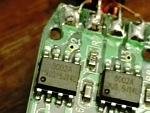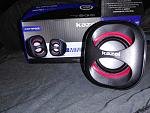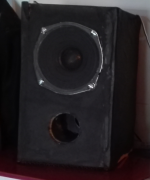Dolby's is, BBE's is to colour the sound, though they say it's to clarify, but their premise about non amplified sound and the effects of amplification are both wrong, certainly in the article I quoted from. The reason this is important is because they say it is this damage to the original that BBE corrects.They're intention is to clarify the sound.
What phase inaccuracies?bbe processes signals to remove phase inaccuracies.
...whilst bbe processes signals to remove phase inaccuracies...
😛 Nope it adds other phase inaccuracies because it doesn't know the systems particular phase graph so for true waveshape correction/repair its nothing but sales talk, but its probably a fine effects processor for some.
...They're intention is to clarify the sound.
Please BBE is to stick out or shape the sound should anybody like it.
So guys... what is missing then is a very detailed explanation from the creators of the BBE processor as to exactly how the amplified sound differs from live performances.
It would seem from the input here.. that BBE is a solution to a problem with amplified sound that does not exist.
It would seem from the input here.. that BBE is a solution to a problem with amplified sound that does not exist.
Well then lets hear it...On the contrary, it assumes a lot of ignorance and is written to impress such people. It does not appear to be technobabble; it is technobabble. The only question is whether the author actually believes it himself; is he foolish or dishonest?
I am pleased to hear that you have some understanding of impedance.
I spoke too soon. You don't understand impedance.
Only if the radiating 'centre' of the speaker is displaced. If so, this would normally be corrected to some extent in the crossover network; it certainly cannot be corrected generically by some external effects box. Therefore their claim lacks plausibility; in fact it is worse than that, it possesses a ring of untruth.
We can. We suspect you cannot.
Nope BBEs intention is to apparently correct for phase inacuracies. That's their stated objective.😛 Nope it adds other phase inaccuracies because it doesn't know the systems particular phase graph so for true waveshape correction/repair its nothing but sales talk, but its probably a fine effects processor for some.
Please BBE is to stick out or shape the sound should anybody like it.
I wasnt saying that those inaccuracies were corrected nor that they are definitely there. But the intention by the creators has been stated to adjust for them so ... if we consider the creators intention rather than their effectiveness then it can ve said that both are INTENDED to clarify the music...please dont confuse their intention with whether it works or whether the problem wxusts. I am only statong their intention.
@cop Ahhh... found the quick reply.
Is this better ?
Sorry for the delay.
Gettimg ysed to tapatalk and a crummy keyboard layout.
Is this better ?
Sorry for the delay.
Gettimg ysed to tapatalk and a crummy keyboard layout.
...that BBE is a solution to a problem with amplified sound that does not exist.
Guess there exists problems with amplified sound but them i can think of in chain be it recording to reproduction gear except some few amp stages very few devices can do smooth all the way from DC up to light speed or say 300kHz-1mHz area, BBE looks operate in 20Hz-20Khz so nothing it can do here.
Last edited:
Casette tapes: as mentioned a few posts ago. I am about to connect a casette player to my existing micro-amp speaker setup and check.
In the meantime:
The other analog format: Cassette tape decks have never been cheaper to buy - CNET
SONY TC-KE500S Audio Cassette Deck - Product Review
In the meantime:
The other analog format: Cassette tape decks have never been cheaper to buy - CNET
SONY TC-KE500S Audio Cassette Deck - Product Review
The highs exhibited more distortion (you really have to be looking for it) on intense passages than when played back through the SONY TC-KE500S, but the overall recording was definitely of better quality than anything I could hear over the air with the car FM Stereo radio. Mission accomplished! I now look forward to making tape copies of some of my favorite CDs and vinyl to take on the road
 @BasicHiFi1 - Is this the system you are working on?
@BasicHiFi1 - Is this the system you are working on?I post pictures of my current systems
If so, you may want to merge the two threads, so people know where you are coming from...
@BasicHiFi1 - Is this the system you are working on?
I post pictures of my current systems
If so, you may want to merge the two threads, so people know where you are coming from...
Not exactly. I was trying to get an idea of what sort of target sound response to aim for at low levels of listening - 64 dB and 60 dB at approximately one metre.
The discussion has made me realize the error of overemphasizing the bass, and a recent listen on my ESS system (Sony STR -333S receiver + Sony SS 333 ) and then on the 8002A USB amp + my low cost speakers has satisfyingly shown me that I am getting similar tonal balances to my ears. The sound is pleasing, revealing if not clear, and the stereo imaging (listening in the near field at 70 cm from the speakers ) is good, something I have not heard before like this.
You raise a good point, I will list all the systems I have listened to so people will know where I am coming from. Right now, I value my desktop 8002 based system the most. I used to listen on headphones as well in the 1980s.
Last edited:
I think it's also important to expose yourself to as much live sound, ideally, real instruments as well. I appreciate that this isn't easy
Yap! No amplification, nor ear-killer bum-bum, just the instruments that have been selected in history as well balanced and good sounding.
And...there are many in an orchestra.
And...there are many in an orchestra.
You mean electric( ified) instruments ? Of course !
Bass guitar, guitar, keyboards, voice via microphone, etc.
But you'll hear the sound PROCESSED by the electronics ( and transformed into acoustic by the speakers, so another passage )
If you want to hear a live instrument playing, you've got to hear a live instrument playing.
Then you'll get your imprinting...brain processing, memory, same PROCESSING but inside you, as, we're human... aren't us ?🙄
Bass guitar, guitar, keyboards, voice via microphone, etc.
But you'll hear the sound PROCESSED by the electronics ( and transformed into acoustic by the speakers, so another passage )
If you want to hear a live instrument playing, you've got to hear a live instrument playing.
Then you'll get your imprinting...brain processing, memory, same PROCESSING but inside you, as, we're human... aren't us ?🙄
Not "unplugged" and acoustic they don't. Having said that even classical venues often use sound reinforcement these days......... As I said, it isn't easy.
Pico's right, we learn how to hear, and experience enables a more enjoyable or even realistic psychoacoustic effect when we listen to our hi-fi
Pico's right, we learn how to hear, and experience enables a more enjoyable or even realistic psychoacoustic effect when we listen to our hi-fi
Last edited:
OR...as the title of the thread says, if you cannot hear it live, you can do it DEAD...I mean...there is a procedure called mic'ing and then storage then playback with a playback system that should guarantee there is no added information ( noise, whatever...) other than that .
For the reason exposed, I cannot stand more than 5 seconds in that situation.even classical venues often use sound reinforcement these days......... As I said, it isn't easy
They kill music

- Home
- General Interest
- Everything Else
- Music Reproduction Systems - what are we trying to achieve?




